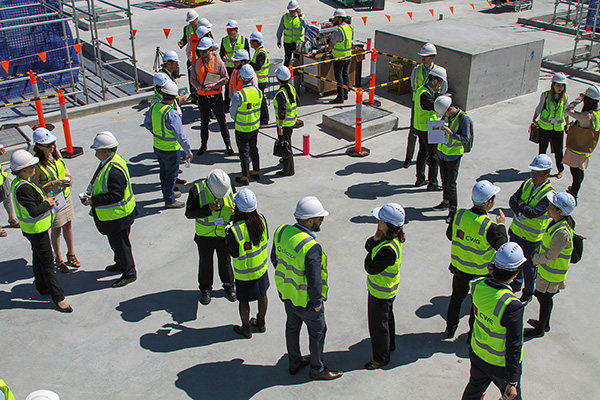Among heightened industry volatility, U.S. manufacturers can rely on transformation, innovation, and automation for stability.
By Tyler Marshall, Regional Vice President of Manufacturing, Advantive
U.S. manufacturers are facing some harsh realities. With tariff rates hitting their highest levels in nearly a century and an industry-wide labor shortage creating major workforce setbacks, manufacturers need to adapt quickly or face the possibility of closure.
These issues are daunting, but surviving a turbulent environment isn’t impossible. With the right tools and strategies, manufacturers can maintain efficient operations and may even uncover some unexpected gains. Solutions like advanced automation and digital manufacturing systems can help companies streamline processes, offset tariff-induced costs, and remain competitive even as unpredictable landscape shifts become the norm.

Tariff hikes are creating significant volatility in the manufacturing industry. The average effective tariff rate on imports is 17.8%, marking its highest point since 1934 and a 612% year-over-year increase from the 2024 rate of 2.5%. The recent increases are wreaking havoc on manufacturers by driving up production costs — as many suppliers pass tariff expenses on to businesses — and disrupting supply chains. In May, supplier delivery times reached their longest in nearly three years, raising concerns about potential shortages.
The reduced profit margins are making it difficult for manufacturers to stay afloat, and that’s without factoring in the industry’s ongoing labor shortage. According to a recent Deloitte report, the manufacturing industry could require 3.8 million new employees by 2033, and 1.9 million of those positions may go unfilled if the current workforce gap persists. Predictably, 65% of manufacturers point to recruiting and retaining employees as their top business priority, yet the manufacturing industry reported 450,000 open jobs in March.
Faced with dual crises and seeking innovative ways to do more with less, more manufacturers are turning to technology as a critical tool. Automation, in particular, is becoming popular among companies as a practical way to bridge skill gaps, uphold standards, and keep productivity on track.
Automation offers a multifaceted solution by easing both tariff-related financial pressure and labor shortages so manufacturers can increase efficiency and reduce costs without sacrificing quality. Automated systems streamline processes and cut the time required to complete tasks. With 24/7 operation capabilities, machines can significantly enhance production rates and capacity. For example, automated assembly lines allow manufacturers to ramp up output and remain competitive despite high tariffs and smaller teams.
While manual labor shortages persist, automation can help maintain operational performance without raising labor costs or introducing the potential for error. Fewer costly mistakes translates into more consistent quality. To further ensure high-caliber products and boost customer trust, automated systems are equipped with advanced sensors and monitoring tools that detect defects and irregularities more accurately than manual inspections.
Another way manufacturers can lower costs is by avoiding workplace accidents, and that starts with minimizing the number of hazardous jobs employees are assigned. Automating perilous work — such as heavy lifting, handling chemicals, or operating in extreme temperatures — can improve employee safety and reduce costly incidents. The average workplace injury can take a heavy toll on employers when factoring in both direct and indirect expenses. While workers’ compensation claims typically average around $41,000, additional costs like lost productivity, recovery time, and administrative tasks can push the total much higher.
Automation’s adaptability and flexibility extend beyond dangerous environments to uncertain markets, which often demand rapid changes in production. Systems that can be reprogrammed quickly to generate different products and quantities help manufacturers adjust to trends and gain the agility needed to withstand unpredictable periods.
To sustain a long-term competitive advantage, manufacturers can further enhance automation capabilities by investing in fully integrated digital solutions. These systems can future-proof operations by providing real-time data, predictive analytics, and enhanced decision-making tools. Digital solutions collect and analyze information from across the production line, offering insights that improve efficiency and reduce downtime.
For example, predictive maintenance tools can identify potential equipment failures before they occur, which is key to avoiding delays. When they do occur, malfunctions and disruptions can be incredibly expensive. According to a 2024 Siemens report, hourly downtime can cost businesses anywhere from $36,000 in the fast-moving consumer goods sector to $2.3 million in automotive. These costs add up fast, driven by idle workers, repair bills, stalled production, supply chain disturbances, and reputational fallout.
Other technologies, such as cloud-based platforms and enterprise resource planning solutions, enable seamless communication and collaboration between teams, even across multiple facilities. Leveraging the power of these integrated systems, which are designed to grow with the businesses using them, refines operations and speeds problem-solving so manufacturers can scale effortlessly as demand increases. These tools address current challenges and prepare manufacturers to endure future uncertainty, whether it’s new tariffs or more supply chain interruptions.
Change is inevitable, but how manufacturers respond to it will shape their future. Steep tariff hikes and a persistent labor shortage are challenges that require more than just endurance. The situation demands transformation, and automation offers a way forward with tools to mitigate the impact of industry pressures and contribute to businesses’ long-term success.
Automating processes and layering in fully integrated digital solutions can fortify manufacturers’ operations and guard against disruption amid unpredictable market and economic conditions. Embracing these innovations to reduce costs, improve safety and boost productivity will create the agility needed to respond to an ever-changing global landscape. This is how organizations build a more resilient, competitive future for American manufacturing.

About the Author
Tyler Marshall, Regional Vice President of Manufacturing at Advantive, worked with ParityFactory of the Advantive family for over a dozen years, providing software solutions for food manufacturers. Beginning with the Alaskan Seafood industry, he has designed and successfully implemented the ParityFactory platform at operations across all food verticals from $5 million to over $1 billion in revenue, ultimately providing them millions in savings.
In this episode, I sat down with Beejan Giga, Director | Partner and Caleb Emerson, Senior Results Manager at Carpedia International. We discussed the insights behind their recent Industry Today article, “Thinking Three Moves Ahead” and together we explored how manufacturers can plan more strategically, align with their suppliers, and build the operational discipline needed to support intentional, sustainable growth. It was a conversation packed with practical perspectives on navigating a fast-changing industry landscape.